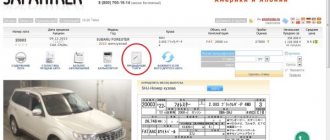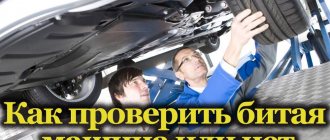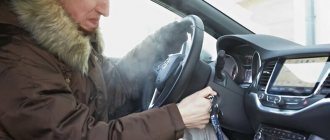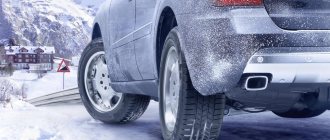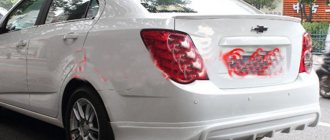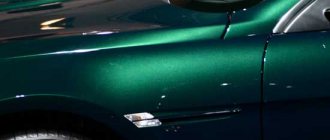Buying a car is usually a long-awaited and exciting moment. Often purchasing a car is a necessity. So first of all, it is important to decide what you need the car for. Situations vary. For example, you need to get to work, take your children to school or kindergarten, visit shops and clinics. For a city car, the main requirement is efficiency, especially if you often have to sit in traffic jams. A petrol jeep is clearly not suitable here. But if a car is needed for country trips by outdoor enthusiasts or avid summer residents, then a sedan or sports coupe with a low seating position and small interior and trunk volumes will clearly be inappropriate. As for the marital status of the buyer, it is also not the least important. In other words, a small car for a young girl is exactly what she needs. But a large family will feel cramped.
Checking the car before purchasing
Having already decided what the car is needed for, who it will transport and what roads to drive on, you can seriously narrow the boundaries within which difficult choices have to be made. In addition, it is important to decide on the amount that you can spend on the purchase. Do not forget that the final cost of the car will be approximately 20–30% higher than the figure quoted by the seller. After the purchase, re-registration, insurance and, most likely, repairs will certainly follow, because most used cars require the intervention of a diagnostic and repair technician.
It’s not enough to just buy a car, you will need to maintain and service it.
The cost of maintenance consists of the following factors:
- fuel consumption and the price of this same fuel,
- cost of annual insurance,
- cost of maintenance every 10–20 thousand km,
- repair costs.
So that the last point does not upset you too much later, it is important to find the best option at the stage of choosing a car.
Visual inspection
Checking a car before purchasing begins with its external inspection. Experienced mechanics recommend performing the following steps:
- A visual inspection will allow you to determine whether the external data of the equipment corresponds to the age specified in the document. So, for example, clearly noticeable rust should not be present on a car that, according to papers, is only 1-2 years old.
- You should find the VIN code of the car. This is a kind of identifier that will allow you to find out almost everything about the item for sale. It can be located in the lower right corner of the windshield, on the fender under the hood and on the floor of the cabin near the front seat. The code can be used at the next stage of verification, when the buyer proceeds to study the “history” of the vehicle.
- An external inspection of the car before purchase will allow you to check for dents and scratches on the body.
- We must not forget about checking the gaps between body parts. They must be uniform, otherwise there is a high probability that this used car has been in an accident.
- All vehicle doors and trunk are subject to thorough inspection. They must be easy to open and close, and all locks must be in good condition.
- You can't ignore your car tires. Uneven wear may indicate quite serious problems in the operation of the machine.
- Lighting fixtures and the alarm system must undergo mandatory inspection.
There are still many things that you need to pay attention to when buying equipment second-hand, but these signs are enough to determine its serviceability.
Risks associated with buying a used car
There are quite a lot of scammers and simply unscrupulous sellers in the automobile market. And in order to sell illiquid property, various schemes are being undertaken. Buyers are deceived by hiding the following information from them:
- The car is wanted. This is perhaps the most difficult case, when the buyer risks being left without money, a car, and may also be prosecuted as an accomplice. A car can be wanted for two reasons: the vehicle was stolen or was used in criminal cases.
- The car is pledged. The second reason why buying a used vehicle can result in a loss of money. If the car is pawned at a pawnshop or bank, it will be confiscated to pay off the debt. And although the laws are now on the side of buyers who were not aware of the encumbrance, there will be many problems with such a car.
- The car was seized by bailiffs. For debts on fines, taxes, alimony, utility bills, bailiffs can confiscate property. And most often transport is hit. Such a car cannot be sold, exchanged, or deregistered. Therefore, buyers will learn about the arrest at the traffic police when it comes time to re-register the car.
- The car was seriously damaged in an accident. Many sellers hide the fact that they were involved in an accident that resulted in serious damage to internal parts or bodywork. To prevent the buyer from finding out about the accident, parts are changed and the metal parts of the body are repainted. In appearance, such a car cannot be distinguished from a “fresh” one, but its cost will be several times lower. During operation, the consequences of the accident will become visible to the naked eye. It's even worse if the car was drowned. In this case, the service life of the vehicle is reduced by a couple of decades, parts quickly become corroded, and headlights become covered in perspiration. Driving such a car is very dangerous.
- The mileage is twisted. Every buyer has to know the real mileage of the car. This allows you to assess the degree of wear of internal parts and calculate how long the machine will last with good maintenance. But the higher the mileage, the lower the cost of transport, so sellers often distort the data and twist the odometer readings.
- The car had many owners. Repeated resale of vehicles is a bad sign. It is possible that this is an accident, but most often such cars have significant shortcomings, so they do not stay in the same hands.
There may be other problems with the machine. For example, if the owner worked on it in a taxi, then the parts will be worn out more than in a car that was used only for personal purposes.
Vehicle interior
Checking a car before purchasing involves inspecting the interior. Attention is drawn to:
- state of internal lighting;
- the presence of chips and cracks on the glass;
- presence of foreign odors;
- operation of existing switches;
- the functioning of the instrument panel indicators, and the panel itself for cracks;
- ease of gear shifting;
- operation of the air conditioner and stove;
- handbrake condition;
- functioning of seat belts;
- operation of systems that regulate the position of seats.
At the end of the inspection, you need to lift the floor mats to check the condition of the underbody. The trunk is also checked for damage and rust. This completes the visual check.
Inspecting the engine compartment
Before you start an instrumental engine check on a special stand or in a service station engine workshop and using special equipment (the same computer, for example), you should carefully inspect the engine and attachments. An experienced glance will be enough to establish the general characteristics of the “health” of the motor. There should be no leaks of oil or other operating fluids either on the cylinder block or on the internal panels of the engine compartment (mud flaps, partitions, wheel arch aprons, etc.). A light coating of dust is not scary, it’s actually good. On such a slightly dirty surface, such streaks will be clearly visible. But the freshly washed engine and engine compartment, shining so brightly with their almost conveyor belt cleanliness, should alert you. Did the seller want to hide traces of the same drips?
Also inspect the exhaust pipe. The inside should look like black velvet fabric and be dry. A thick black coating from the inside indicates that the engine is “eating” oil and it flies out into the exhaust system. Drops of water are not a big deal, condensation always happens in the exhaust system, the main thing is that there is no stream of exhaust from the exhaust tip.
When the engine is running, the exhaust should be almost colorless. Blue smoke may indicate oil burning in the cylinders, black smoke may indicate unburned fuel particles. There are many shades of gray or black smoke, and only a professional mechanic can confidently diagnose the condition of the engine without special tools. If you have such an assistant next to you, just such a “second pair of eyes,” then your conversation with the seller will definitely flow in a more productive direction.
Testing the operation of units
Buying a used car requires a thorough check of the functioning of components and assemblies. It’s good if the buyer understands technology or can invite a mechanic he trusts. If this is not possible, you should take the vehicle for diagnostics to a car service center. It is important that both future parties to the transaction are present. The mechanic can identify deficiencies that should be made known to both the buyer and the seller. They can agree to fix problems at the owner's expense or to reduce the price.
It is advisable to seek formal advice. The document received after the diagnosis will allow the future owner to know the “problem areas” of his purchase and control the operation of the car.
Checking your car for fines
There is always a possibility of purchasing a car with outstanding fines. Often, sellers themselves do not know about the debts to the traffic police, but sometimes they deliberately withhold information so that all debts fall on the new owner.
Of course, if you buy such a car, you cannot be forced to pay these fines; this is the responsibility of the former owner. However, there are situations when, due to non-payment of fines, registration restrictions are imposed on the car. In this case, the new owner will not be able to register the car.
To identify the presence of fines, you can use the following services:
- official website of the traffic police;
- Autocode service.
To check a vehicle through the official website of the traffic police, you need to know how the state. car number and registration certificate number. To check using the Autocode service, it is enough to know the state code. car number. At the same time, from the report, in addition to the history of fines, you will find out information about mileage, technical. inspections, compulsory motor liability insurance, restrictions and much other important information.
Legal purity of technology
The purchased car must not only be in proper technical condition, but also not bring problems with the law to the new owner. Therefore, it must be checked for legal purity.
Changes in the current legislation have simplified the procedure for registering the purchase and sale of vehicles. If previously the “history” of a car could be found out by a lawyer completing a transaction, now this function will have to be performed by the buyer or seller.
Human rights activists do not recommend ignoring the check. Situations are different, so you should play it safe and study the vehicle’s past.
Carrying out an inspection will reveal:
- the owner has unpaid fines;
- participation of a motor vehicle in traffic accidents;
- whether this car is pledged or under arrest;
- whether the car has been stolen and whether there are other prohibitions on its alienation.
Buying an untested car can lead to lengthy legal proceedings, as well as loss of money.
Checking for restrictions
Beware of car purchases that are subject to restrictions. Read in the special material all about the restrictions on cars and what they can mean for the new owner.
In what cases are restrictions imposed:
- if the customs authorities have suspicions that the vehicle was cleared through customs under a “gray” scheme;
- if the vehicle is the subject of a dispute in court;
- if the owner of the car is obliged by court to pay a bailiff a certain amount of money.
You can check your car for restrictions on the official website of the traffic police. To do this, you need to know the VIN code or chassis number.
The check can also be carried out through the official website of the bailiffs. To do this, you need to know the owner’s passport details, SNILS or TIN.
Users of the Autocode service can find out about the restrictions imposed on vehicles by state. number.
How to check the car?
If a used car is purchased at a dealership, then a certificate of its legal purity can be requested from the official seller.
What should those who do not have the opportunity or desire to use this method of acquiring property do? The parties to the contract will have to carry out the verification themselves. This can be done this way:
- Contact the traffic police. The State Traffic Inspectorate will definitely ask about the reason for such “curiosity”, since they are not obliged to provide such information.
- Use the official traffic police portal to check. This is the most effective and popular way to obtain data. The site is open to the public and anyone can request information on it. The advantages of the portal are obvious - it is regularly updated, so the data on it is always up to date.
- Information about whether the car is under arrest or pledged can be obtained on the website of the Bailiff Service or the Notary Office.
- Today there are many information portals on the Internet that offer their databases. These are usually paid services. But, as practice shows, information on portals arrives with some delay, so it is impossible to prepare for their relevance.
You should not neglect checking. Problems with the cleanliness of a vehicle do not always arise due to the seller’s dishonesty. There are situations when the owner of the equipment himself does not know about the presence of unpaid fines, so experts recommend having it checked regularly.
0
I twist and turn, I want to confuse!
Sad statistics: more than 50% of car sellers underestimate the mileage. After this, the owner of the car increases the sale price by a larger amount. Tricky, isn't it?
Information about a car's mileage can be obtained in the following ways:
- Carefully check the documentation: service book and invoices for repair work. As a rule, it indicates the mileage of the car when this or that work was carried out;
- Carry out a thorough inspection with the help of specialists. Here we mean auto experts who come out with diagnostic equipment, connect to the “brains” of the car and look at many indicators, for example, error history. And based on a number of factors, they draw conclusions about the “torsion of the mileage”, and sometimes they go so far as to look at the “wear” of the steering wheel and seats;
- Before meeting your beauty, just in case, go to Avtoteka. Through the service, you can check the mileage history of a used car, since it has access to the necessary databases: official dealers and car services that carry out maintenance.
Test Drive
In order to fully and “completely” check a car before purchasing, a test drive, of course, needs to be carried out. But such a “procedure” is more likely to understand the car, to listen to how it works, and whether it “fits your soul .” If this is a car of ancient vintage, then they listen to everything in it, from the characteristic (or, conversely, uncharacteristic) sounds that the engine and chassis with transmission make, to the sensations from the steering and the effectiveness of the brakes. However, in a modern car, all this is checked on dynamometer and vibration stands. And also on a lift, on a viewing hole, and using special tools. For a long time now, no one has been checking wheel alignment, or play and clearances in the steering, and the effectiveness of braking systems is checked exclusively on running drums. And all the information is laid out in graphs and figures either on a computer monitor or in printed form - on paper from a printer. For delivery to the client and filing it in the Service Book.
How to check a car when buying, they can tell you in detail (and show you in numbers and graphs) only at a service station that specializes in the brand of the car you are buying. This will be the most correct method of testing and diagnosis.




